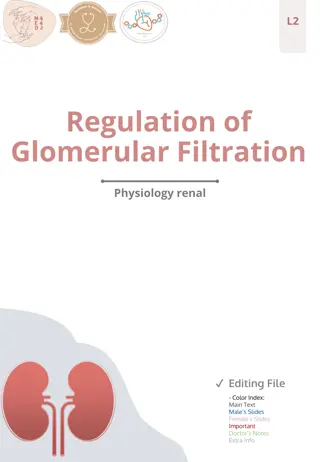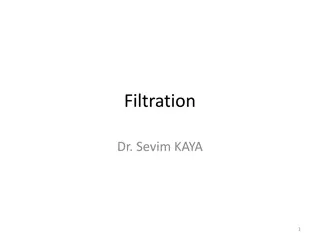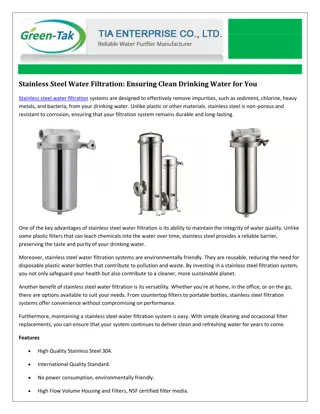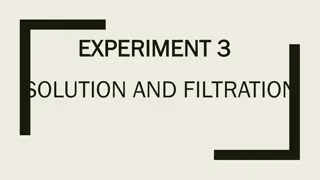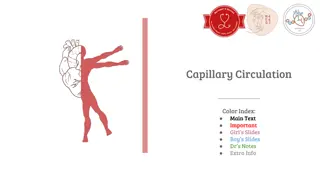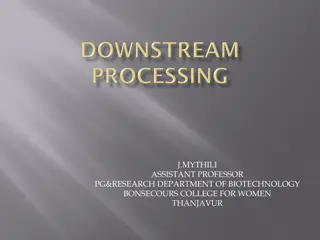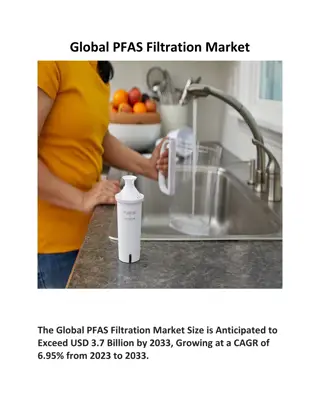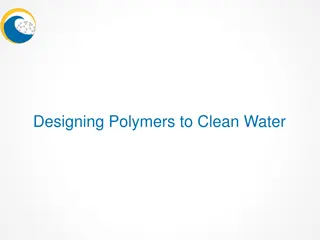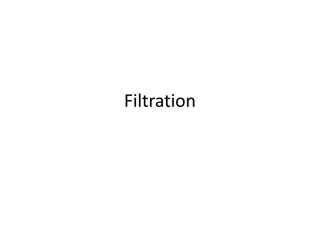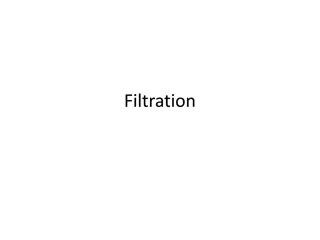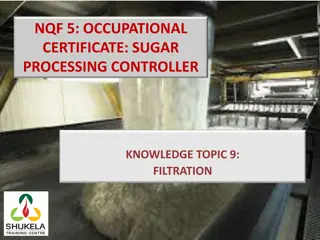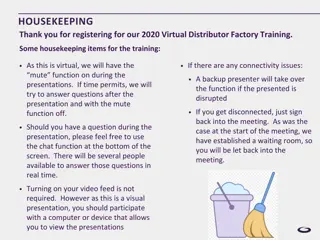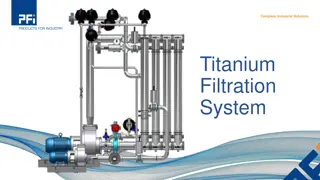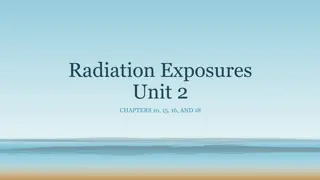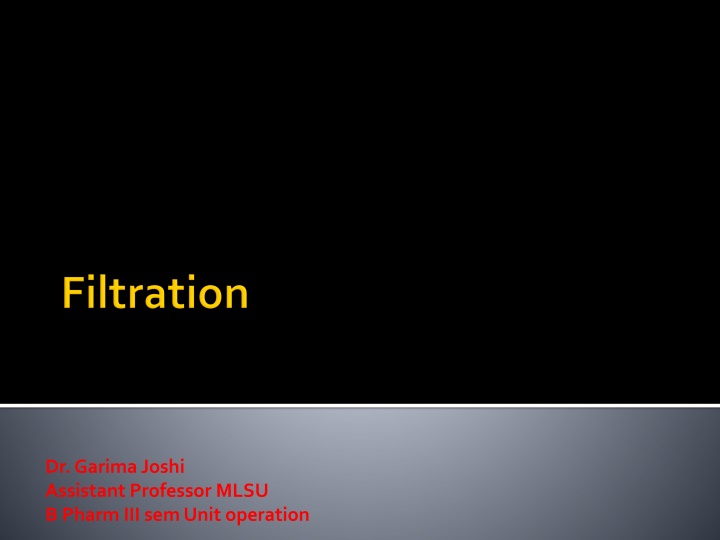
Filtration Processes and Techniques Explained in Detail
Understand the concepts of filtration, clarification, and production of sterile products through HEPA filters in this comprehensive guide. Learn about mechanisms such as straining, impingement, and entanglement, which aid in the separation of solids from liquids. Discover the differences between surface/screen filtration and depth filtration methods, along with the essential rules governing liquid flow through filters.
Download Presentation

Please find below an Image/Link to download the presentation.
The content on the website is provided AS IS for your information and personal use only. It may not be sold, licensed, or shared on other websites without obtaining consent from the author. If you encounter any issues during the download, it is possible that the publisher has removed the file from their server.
You are allowed to download the files provided on this website for personal or commercial use, subject to the condition that they are used lawfully. All files are the property of their respective owners.
The content on the website is provided AS IS for your information and personal use only. It may not be sold, licensed, or shared on other websites without obtaining consent from the author.
E N D
Presentation Transcript
Dr. GarimaJoshi Assistant Professor MLSU B Pharm III semUnit operation
Filtration: It may be define as a process of separation of solids from a fluid by passing the same through a porous medium that retains the solids but allows the fluid to pass through. Clarification: When solid are present in very low concentration, i.e., not exceeding 1.0% w/v, the process of its separation from liquid is called clarification.
Slurry: Suspension to be filtered Filter medium Filter medium: Porous medium used to retain solid. Filter cake: Accumulated solids on the filter. Filtrate: Clear liquid passing through the filter.
Production of sterile products: HEPA filters or laminar air bench Membrane filters. Production of bulk drugs Production of liquid dosage Effluents and waste water treatment
The mechanism whereby particles are retained by a filter : Straining: Similar to sieving, i.e., particles of larger size can t pass through smaller pore size of filter medium. Impingement: Solids having the momentum move along the path of streaming flow and strike (impinge) the filter medium. Thus the solids are retained on the filter medium. Entanglement: Particles become entwined (entangled) in the masses of fibres (of cloths with fine hairy surface or porous felt) due to smaller size of particles than the pore size. Thus solids are retained within filter medium. Attractive forces: Solids are retained on the filter medium as a result of attractive force between particles and filter medium, as in case of electrostatic filtration.
Surface/ screen filtration: It is a screening action by which pores or holes of medium prevent the passage of solids. Mechanism involved : straining and impingement. For this, plates with holes or woven sieves are used. Depth filtration: In this slurry penetrates to a point where the diameter of solid particles is greater than that of the tortuous void or channel. Mechanism : Entanglement. The solids are retained with a gradient density structure by physical restriction or by adsorption properties of medium.
Surface Filtration Depth Filtration
The flow of liquid through a filter follows the basic rules that govern the flow of any liquid through the medium offering resistance. The rate of flow may be expressed as- The rate of filtration may be expressed as volume (litres) per unit time (dv/dt). Driving force = pressure upstream pressure downstream Resistance is not constant. It increases with an increase in the deposition of solids on the filter medium. Therefore filtration is not a steady state.
Poiseullie considered that filtration is similar to the streamline flow of liquid under pressure through capillaries. Poiseullie s Equation is- Where, V = rate of flow, m3/s (l/s) P= Pressure difference across the filter, Pa r = radius of capillary in the filter bed, m L = thickness of filter cake (capillary length), m ? = viscosity of filtrate, Pa.s If the cake is composed of bulky mass of particles and the liquid flows through the interstice, then flow of liquids through these may be expressed by this equation.
Poiseullie's law assumes that the capillaries found in the filter are highly irregular and non-uniform. Therefore, if the length of capillary is taken as the thickness of bed, a correction factor for radius is applied so that the rate is closely approximated and simplified. The factors influencing the rate of filtration has been incorporated into an equation by Darcy, which is: Where, K = permeability coefficient of cake, m2 A = surface area of porous bed (filter medium), m2 Other terms are same as previous equation K depends on characteristics of cake, such as porosity, specific surface area and compressibility.
Permeability may be defined quantitatively as the flow rate of a liquid of unit viscosity across a unit area of cake having unit thickness under a pressure gradient of unity. This equation is valid for liquids flowing through sand, glass beds and various porous media. This model is applied to filter beds or cakes and other types of depth filter. This equation is further modified by including characteristics of K by Kozeny-Carman.
Kozeny-Carman equation is widely used for filtration. Where, ? = porosity of cake (bed) S = specific surface area of particles comprising the cake m2 / m3 K = Kozeny constant (usually taken as 5) Other terms are same as previous equations Limitations: It does not consider the fact that depth of granular bed is lesser than the actual path traversed by the fluid. The actual path is not same through out the bed, but it is sinuous or tortuous.


